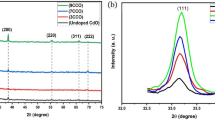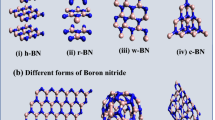Abstract
We report on the effect of precursor chemistry on ZnO nanorods (NRs) growth and their hydrogen sensing characteristics probably for the first time. We found that zinc acetate grown nanorods were dislocated at the center and showed better sensitivity towards hydrogen gas than conventional NRs without dislocation. For nanorods growth, a ZnO seed layer of thickness 80 nm was deposited by RF sputtering at room temperature over SiO2/p-Si substrate; oxidation in silicon substrate was done by the thermal oxidation method. The crystalline phases and the surface nanostructure of the ZnO thin film (seed layer) were investigated by the X-ray diffraction and atomic force microscope. The ZnO nanorods’ surface morphology and their crystalline nature were studied by SEM and X-ray diffraction. The chemical properties of the ZnO nanorods were investigated by the X-ray photoluminescence spectroscopy. Using DC sputtering and shadow mask, Ti (80 nm)/Au (100 nm) metal layers were deposited over the ZnO nanorods to fabricate a metal semiconductor metal structure for sensor fabrication. I–V characteristics of the devices were obtained by the semiconductor parameter analyzer. The hydrogen gas was exposed over the devices using mass flow controller, and it was found that device containing nanorods grown by zinc acetate shows 98% sensitivity for 24 ppm gas concentration in a nitrogen atmosphere that was the largest reported till date than with bare conventional non-dislocated NRs.
Access this article
We’re sorry, something doesn't seem to be working properly.
Please try refreshing the page. If that doesn't work, please contact support so we can address the problem.





Similar content being viewed by others

References
A.B. Yadav, S. Jit, Particle size effects on the hydrogen sensing properties of Pd/ZnO Schottky contacts fabricated by sol–gel method. Int. J. Hydrog. Energy 42(1), 786–794 (2017)
S.Y. Chiu, H.W. Huang, K.C. Liang, K.-P. Liua, J.-H. Tsaib, W.S. Loura, Comprehensive investigation on planar type of Pd-GaN hydrogen sensors. Int J Hydrog Energy 34(13), 5604–5615 (2009)
S. Basu, A. Dutta, Modified heterojunction based on zinc oxide thin film for hydrogen gas-sensor application. Sens Actuator B 22(8), 3–7 (1994)
K.L.P. Thi, L.T. Nguyen, N.H. Ke, D.A. Tuan, T.Q.A. Le, L.V.T. Hung, The morphology and optical properties of ZnO nanorods grown on MoS2 thin films at various thicknesses using a chemical bath deposition method. J Electron Mater 47, 6302 (2018)
Dong-Hau Kuo, Jheng-Yu. He, Ying-Sheng Huang, Synthesis of vertically aligned ZnO nanorods on Ni-based buffer layers using a thermal evaporation process. J Electron Mater 41, 451 (2012)
B.S. Sannakashappanavar, C.R. ByrareddyPesala, S. Kumar, A.B. Yadav, Superlattices Microstruct. 117, 503–514 (2018)
K.H. Tam, C.K. Cheung, Y.H. Leung, A.B. Djurisic, C.C. Ling, C.D. Beling, S. Fung, W.M. Kwok, W.K. Chan, D.L. Phillips, L. Ding, W.K. Ge, Defects in ZnO nanorods prepared by a hydrothermal method. J. Phys. Chem. B 110, 20865–20871 (2006)
J.X. Wang, X.W. Sun, H. Huang, Y.C. Lee, O.K. Tan, M.B. Yu, G.Q. Lo, D.L. Kwong, A two-step hydrothermally grown ZnO microtube array for CO gas sensing. Appl. Phys. A 88, 611 (2007). https://doi.org/10.1007/s00339-007-4076-8
A. Zainelabdin, S. Zaman, G. Amin, O. Nur, M. Willander, Optical and current transport properties of CuO/ZnO nanocoral p–n heterostructure hydrothermally synthesized at low temperature. Appl. Phys. A 108, 921 (2012). https://doi.org/10.1007/s00339-012-6995-2
Shu-Yi Liu, Tao Chen, Jing Wan, Ru Guo-Ping, Bing-Zong Li, Qu Xin-Ping, The effect of pre-annealing of sputtered ZnO seed layers on growth of ZnO nanorods through a hydrothermal method. Appl. Phys. A 94, 775 (2009). https://doi.org/10.1007/s00339-008-4957-5
L.C. Tien, P.W. Sadik, D.P. Norton, L.F. Voss, S.J. Pearton, Hydrogen sensing at room temperature with Pt-coated ZnO thin films and nanorods. Appl. Phys. Lett. 87, 222106 (2005)
H.T. Wang, B.S. Kang, F. Ren, L.C. Tien, P.W. Sadik, D.P. Norton, S.J. Pearton, J. Lin, Hydrogen-selective sensing at room temperature with ZnO nanorods. Appl. Phys. Lett. 86, 243503 (2005)
Sapana Ranwa, Mohit Kumar, Jitendra Singh, Mattia Fanetti, Mahesh Kumar, Schottky-contacted vertically self-aligned ZnO nanorods for hydrogen gas nanosensor applications. J. Appl. Phys. 118, 034509 (2015)
V.S. Bhati, S. Ranwa, M. Fanetti, M. Valant, M. Kumar, Efficient hydrogen sensor based on Ni-doped ZnO nanostructures by RF sputtering. Sens. Actuators B 255, 588–597 (2018)
H. Kim, Y. Pak, Y. Jeong, W. Kim, J. Kim, G.Y. Jung, Amorphous Pd assisted H2 detection of ZnO nanorod gas sensor with enhanced sensitivity and stability. Sens. Actuators B Chem. 262(1), 460–468 (2018)
Hu Xiulan, Yoshitake Masuda, Tatsuki Ohji, Kazumi Kato, Micropatterning of ZnO nanoarrays by forced hydrolysis of anhydrous zinc acetate. Langmuir. 24, 7614–7617 (2008)
Shibu Saha, Vinay Gupta, Influence of surface defects in ZnO thin films on its biosensing response characteristic. J. Appl. Phys. 110, 064904 (2011)
Shu-Yi Liu, Tao Chen, Yu-Long Jiang, Ru Guo-Ping, Qu Xin-Ping, The effect of postannealing on the electrical properties of well-aligned nZnO nanorods/p-Si heterojunction. J. Appl. Phys. 105, 114504 (2009)
M. Wang, F. Ren, G. Cai, Y. Liu, S. Shen, L. Guo, Activating ZnO nanorod photoanodes in visible light by Cu ion implantation. Nano Res. 7, 353–364 (2014)
J. Joo, B.Y. Chow, M. Prakash, E.S. Boyden, J.M. Jacobson, Face-selective electrostatic control of hydrothermal zinc oxide nanowire synthesis. Nat. Mater. 10, 596–601 (2011)
S.A. Morin, M.J. Bierman, J. Tong, S. Jin, Mechanism and kinetics of spontaneous nanotube growth driven by screw dislocations. Science 328, 476–480 (2010)
R. Jaggì, Deviations from Ohm’s law in semiconductors. Phys. Chem. Solids 29, 1699–1702 (1968)
A.B. Yadav, S.S. Basavaraj, True Ohmic contact on RF sputtered ZnO thin film by using the nonalloy Ti/Au metallization scheme. J Alloys Compd 770, 701–709 (2019). https://doi.org/10.1016/j.jallcom.2018.08.166
J.H. Werner, Schottky barrier and pn-junction I/V plots-small signal evaluation. Appl. Phys. A 47, 291–300 (1988)
J. Ouerfelli, M. Regragui, M. Morsli, G. Djeteli, K. Jondo, C. Amory, G. Tchangbedji, K. Napo, J.C. Bernede, Properties of ZnO thin films deposited by chemical bath deposition and post annealed. J. Phys. D Appl. Phys. 39, 1954–1959 (2006)
O. Ovsianytskyi, Y.S. Nam, O. Tsymbalenko, P.T. Lan, M.W. Moon, K.B. Lee, Highly sensitive chemiresistive H2S gas sensor based on graphene decorated with Ag nanoparticles and charged impurities. Sens. Actuators B Chem. 257, 278–285 (2018)
M.R. Modaberi, R. Rooydell, S. Brahma, A.A. Akande, B.W. Mwakikunga, C.P. Liu, Enhanced response and selectivity of H2S sensing through controlled Ni doping into ZnO nanorods by using single metal organic precursors. Sens. Actuators B Chem. 273, 1278–1290 (2018)
S. Ranwa, P.K. Kulriya, V.K. Sahu, L.M. Kukreja, M. Kumar, Defect-free ZnO nanorods for low temperature hydrogen sensor applications. Appl. Phys. Lett. 105, 213103 (2014)
K. Yadav, S.K. Gahlaut, B.R. Mehta, J.P. Singh, Photoluminescence based H2 and O2 gas sensing by ZnO nanowires. Appl. Phys. Lett. 108, 071602 (2016)
Acknowledgements
The authors’ hearty thanks to Indian Nanoelectronics Users Program (INUP) at IIT Bombay for project number P1217182725 and Sophisticated Analytical Instruments Facility at IIT Bombay for completion of this work.
Author information
Authors and Affiliations
Corresponding author
Additional information
Publisher's Note
Springer Nature remains neutral with regard to jurisdictional claims in published maps and institutional affiliations.
Rights and permissions
About this article
Cite this article
Yadav, A.B., Parvathi, P.V.L. & Thabassum, S.R. Effect of precursor chemistry on the structural and sensing properties of hydrothermally grown nanorods. Appl. Phys. A 125, 446 (2019). https://doi.org/10.1007/s00339-019-2740-4
Received:
Accepted:
Published:
DOI: https://doi.org/10.1007/s00339-019-2740-4



